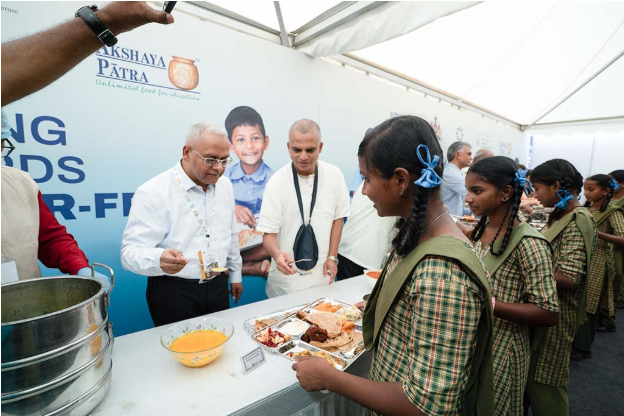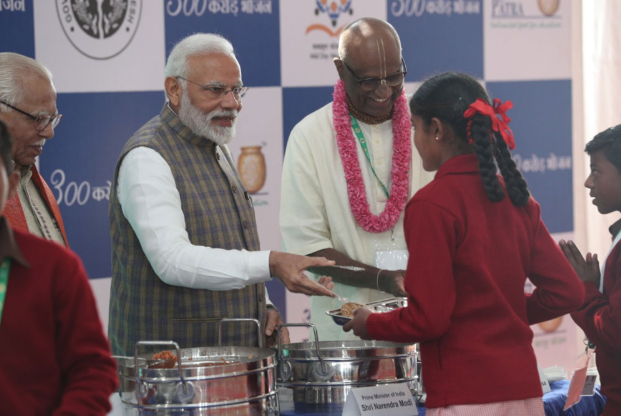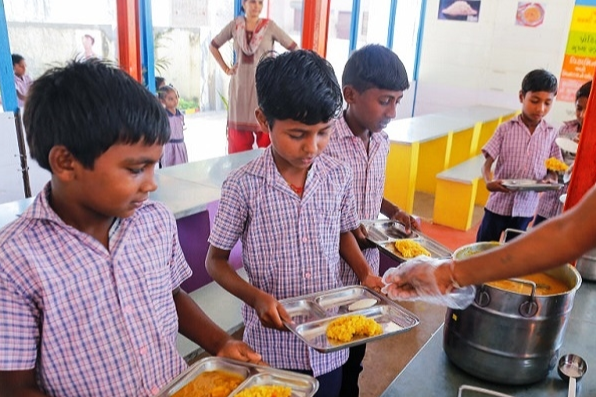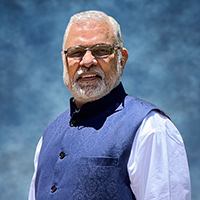Nourishing a Nation: Inside Akshaya Patra’s 25-Year Journey with CEO Shridhar Venkat Ji
Raj Shah

Photo Courtesy: Akshaya Patra
As part of Akshaya Patra Foundation’s 25th anniversary celebration, Forbes India recently sat down with its CEO, Shridhar Venkat Ji, for an in-depth conversation on the organization’s extraordinary journey from feeding 1,500 children in 2000 to serving over 3.35 million meals a day across India.
In this exclusive feature, I bring you an excerpt from that insightful interview, where Venkat Ji reflects on the power of purpose, the partnership with government and private sectors, and the spiritual and operational philosophy that has made Akshaya Patra the world’s largest mid-day meal program. Over a simple, onion-and-garlic-free lunch, Venkat Ji shares not just statistics, but stories of transformation — of hungry children turned confident professionals, of frugal innovations born in temple kitchens, and of a dream to make hunger in schools a thing of the past.
Here is an excerpt from that conversation, first published by Forbes India.
By Raj Shah, Managing Editor,
Desh-Videsh Media Group
When Shridhar Venkat Ji walked away from a promising corporate career in 2006, he was en route to China for a senior role in the private sector. Fate, however, had a different meal plan in mind. A chance meeting with ISKCON monk Madhu Pandit Dasa led him to the Akshaya Patra Foundation—a fledgling NGO serving 1,500 mid-day meals to school children in India. Nineteen years later, Venkat Ji presides over an organization that has become the world’s largest school meal provider, dishing out 2.35 million lunches and one million morning nutrition servings every single day across 25,000 government schools and Anganwadi centres in 16 states and three Union territories.
As Akshaya Patra marks its 25th anniversary on November 11 2025, Venkat Ji reflects on its journey over a simple sattvic lunch—without onion or garlic—offering stories that reveal the organization’s scale, soul, and quiet revolutions.

Mr Shridhar Venkat, CEO, The Akshaya Patra Foundation lends a hand at serving mid-day meals to the beneficiaries. Photo Courtesy: Akshaya Patra
From Boardroom to Bhakti
Venkat Ji describes his move from corporate India to the non-profit world as a leap of faith guided by purpose rather than profit. “When I joined, the development sector was still what I call a jhola culture—idealistic but unstructured,” he recalls. “I believed we could use corporate discipline and technology for good. So, we infused the organization with process-driven systems, performance metrics, and accountability—without losing the missionary spirit.”
This blend of professionalism and devotion, he says, remains Akshaya Patra’s “secret sauce.” The foundation’s management team today includes engineers, MBAs, and chefs working alongside monks and volunteers from ISKCON. “We have a confluence of missionaries and professionals,” Venkat Ji explains. “That combination—selflessness with systems—creates magic.”
Feeding with Dignity
Akshaya Patra’s central philosophy is simple but profound: “No child in India shall be deprived of education because of hunger.” Venkat Ji elaborates, “We can’t match a mother’s meal, but we try to come close.”
The foundation adheres to government nutritional norms—12 grams of protein and 450 calories for primary school children, 20 grams and 700 calories for upper primary—but often exceeds them. Recognizing that many children arrive at school hungry, Akshaya Patra introduced a morning nutrition program now reaching a million children daily, supplementing the flagship mid-day meals.
Each of the foundation’s 67 kitchens functions like a high-efficiency food factory, governed by rigorous quality standards and audits. “We follow good manufacturing practices,” says Venkat Ji. “Every location has a quality officer. Donors like Mr. Ratan Tata have even supported our quality and reserve initiatives.”
Tata, he recalls, personally flew to the Hubli kitchen—then the world’s largest—and offered support in two areas: strengthening quality and building a financial reserve. “We are a hand-to-mouth organization,” Venkat Ji admits. “When funds are delayed, we still have to feed the children. A mother never says no to her child. Mr. Tata helped us create a revolving reserve to ensure the meals never stop.”

3 Billionth Meal Served by The Honourable Prime Minister Shri Narendra Modi at the venue in Vrindavan
Public-Private Partnership Done Right
Over half of Akshaya Patra’s funding comes from the Indian government through the PM Poshan scheme, which Venkat Ji proudly calls a model of partnership. “The government is our big brother,” he says. “We implement its mid-day meal program efficiently and effectively, raising matching funds from donors and multiplying the impact of every rupee.”
He believes this model could solve many national challenges. “Take the top five problems of India—education, nutrition, sanitation, environment, and healthcare—and turn them into public-private partnerships. You’ll see transformation.”
Frugal Innovation and Scale
Innovation, often born of necessity, has fueled Akshaya Patra’s expansion. When the foundation moved north, it had to replace rice and sambar with chapatis to cater to regional tastes. “How do you cook 400,000 rotis in a few hours?” Venkat Ji laughs. “We found a sardarji in Jalandhar who made papad machines. We worked with him to create a roti machine that made 10,000 per hour. Then our engineers scaled it up to 40,000—and now even 60,000 per hour!”
Such frugal ingenuity, combined with missionary entrepreneurship, has kept the kitchens humming. “Our chairman once said, ‘The ability to take risks becomes infinite if you are selfless.’ That spirit drives every innovation here.”
Governance and Transparency
In a sector often shadowed by mistrust, Akshaya Patra’s governance framework stands out. Venkat Ji recounts a turbulent period in 2020 when some trustees resigned amid differences of opinion. “We brought in one of the Big Four firms to conduct a forensic audit. It was 800 pages long, covering three financial years, and found no financial irregularities—just a 0.75 percent error margin. We shared the findings with every donor. Transparency is non-negotiable.”
The foundation has since won accolades, including the Best NGO 2025 Award from the Asian Centre for Governance and Sustainability.

Children being served Akshaya Patra’s mid-day-meal Photo Courtesy: Akshaya Patra
The Monk Managers
Akshaya Patra’s leadership structure remains unique. Venkat Ji reports to two monks—one from IIT Bombay and another from IISc Bangalore. “Actual monks,” he smiles. “They wear the same kind of slippers for 30 years, use the same cloth, and live simply. But they run this organization with scientific precision.”
The trust, though spiritually inspired by ISKCON founder Swami Srila Prabhupada, operates independently with its own secular board and audits. “We are guided by devotion, but governed by systems,” Venkat Ji emphasizes.
Meals Without Onion and Garlic
Over lunch, Venkat Ji dispels a common curiosity about Akshaya Patra’s sattvic menu. “Most people can’t even tell the difference,” he says. “Traditionally, Indian food didn’t have onion and garlic—they came with the Mughals. But there’s also a scientific reason: food without them lasts longer. Our meals meet all nutritional standards and stay fresh for hours. Nutrition and taste go hand in hand.”
Lessons from 25 Years
Reflecting on two and a half decades of growth, Venkat Ji distills Akshaya Patra’s philosophy into five principles: focus, simplicity, innovation, governance, and the fusion of missionary zeal with professionalism. “As organizations grow, bureaucracy creeps in,” he warns. “You must keep it simple and connected to the mission.”
The foundation’s focus has never wavered. “We were once offered ₹120 crore to build toilets,” Venkat Ji recalls. “We declined. Not because it wasn’t noble, but because it wasn’t our core mission. We do only what helps us feed more children.”
Looking Ahead: Nourishing More, Advocating Wider
By 2030, Akshaya Patra aims to triple its morning nutrition program to 3 million servings a day and expand its mid-day meals to reach 3 million children—together amounting to 6 million daily meals or 1.4 billion servings a year. “That’s like feeding one full India every year,” Venkat Ji says with quiet pride.
Yet his ultimate dream is to make Akshaya Patra redundant. “One day, I want this program to be irrelevant,” he says. “When no child in India is hungry, we’ll move on to other missions.”
Part of that vision involves advocacy for change. He recounts how a Kenyan woman, inspired by Akshaya Patra’s Hubli kitchen featured in National Geographic, visited India to learn its model. “She fed 50 children then. Today, her team feeds 350,000 in Kenya and aims for 3 million by 2030. She might even surpass us—and that’s the kind of competition we welcome.”
Feeding Hope, Not Just Hunger
As lunch draws to a close, Venkat Ji smiles when asked about Akshaya Patra’s name. “It comes from Draupadi’s vessel given by the Sun God—an inexhaustible pot of food,” he explains. “Dr Murli Manohar Joshi (former BJP president and Union minister) suggested it. We feed until the child says enough. Sometimes they even take food home.”
Then, almost as a benediction, he adds, “We are just instruments—like the small squirrel helping Lord Rama build the bridge to Lanka. A tiny squirrel, but blessed to be part of something divine.”

About Author Raj Shah
A software engineer by profession, Indian culture enthusiast, ardent promoter of induism, and a cancer survivor, Raj Shah is a managing editor of Desh-Videsh Magazine and co-founder of Desh Videsh Media Group. Promoting the rich culture and heritage of India and Hinduism has been his motto ever since he arrived in the US in 1969.
He has been instrumental in starting and promoting several community organizations such as the Indian Religious and Cultural Center and International Hindu University. Raj has written two books on Hinduism titled Chronology of Hinduism and Understanding Hinduism. He has also written several children books focusing on Hindu culture and religion.




























